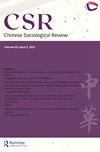A decade of insecurity paradox in contemporary China, 2008–2017
IF 1.4
2区 社会学
Q2 SOCIOLOGY
引用次数: 1
Abstract
Abstract As a primary component of human development program, sense of insecurity (SI) is widely voiced yet unstudied, particularly in developing countries that have gone through a rapid transition, such as China. To map the trend of SI in China, we identify two types, sense of personal insecurity (SPI) and sense of social insecurity (SSI), that have shown opposite trends from 2008 to 2017. While SPI has been declining, SSI seems to grow. To address the extent to which SPI and SSI in China are changing due to age, period, or cohort effects, we adopted a hierarchical age-period-cohort model. The results reveal that period effects are central in defining the trend of SPI and SSI in both rural and urban areas. The changing pattern is largely due to the varying effects of gender, schooling and wealth, three main dimensions of social stratification. Specifically, schooling is more prominent in defining the insecurity pattern in rural areas, while the effects of schooling and wealth are more evident in urban areas.当代中国的十年不安全感悖论,2008-2017
作为人类发展计划的一个主要组成部分,不安全感(SI)被广泛表达但未被研究,特别是在经历了快速转型的发展中国家,如中国。为了绘制中国社会不安全感的趋势图,我们确定了两种类型,即个人不安全感(SPI)和社会不安全感(SSI),这两种类型在2008年至2017年期间呈现相反的趋势。虽然SPI一直在下降,但SSI似乎在增长。为了解决中国SPI和SSI因年龄、时期或队列效应而变化的程度,我们采用了分层年龄-时期-队列模型。结果表明,在确定农村和城市地区的SPI和SSI趋势时,时期效应是中心的。这种变化很大程度上是由于性别、学校教育和财富的不同影响,这是社会分层的三个主要方面。具体来说,在农村地区,学校教育在确定不安全模式方面更为突出,而在城市地区,学校教育和财富的影响更为明显。
本文章由计算机程序翻译,如有差异,请以英文原文为准。
求助全文
约1分钟内获得全文
求助全文

 求助内容:
求助内容: 应助结果提醒方式:
应助结果提醒方式:


